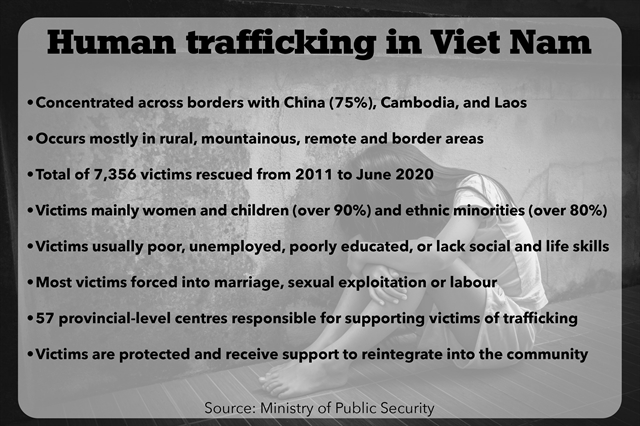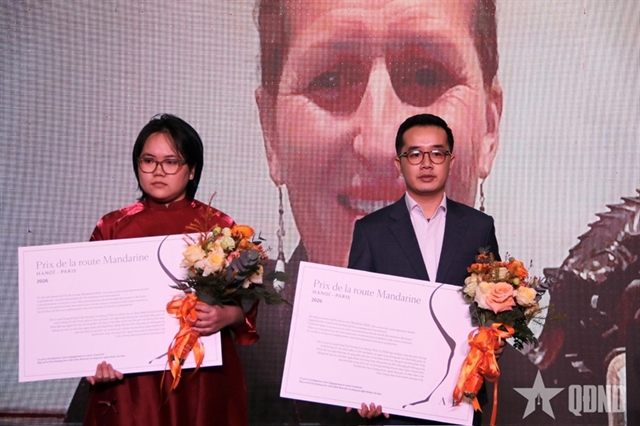 Society
Society

Close cooperation and sharing information with neighbouring countries are some of the most important weapons needed to fight the scourge of people trafficking.

|
| Human traffickers in court in Việt Nam. The highest sentence for human trafficking in Việt Nam is death penalty in cases with serious consequences. Photo courtesy of Blue Dragon Children's Foundation |
Vũ Thu Hà & Paul Kennedy
Close cooperation and sharing information with neighbouring countries are some of the most important weapons needed to fight the scourge of people trafficking.
That’s why Việt Nam’s law enforcement agencies work hand-in-hand with their counterparts in China, Laos, Cambodia and Thailand to catch those responsible for human trafficking.
And it’s not only neighbouring countries Việt Nam works with. Two years ago, a Memorandum of Understanding was signed between Việt Nam and the UK on human trafficking prevention.
The Department of Criminal Police under the Ministry of Public Security is tasked with protecting the country’s most vulnerable who are preyed on by cash-obsessed traffickers trading human beings like pieces of meat.
Lieutenant Colonel Khổng Ngọc Oanh, head of Human Trafficking Prevention Section under the department, said: “The Prime Minister has signed many decisions to approve anti-trafficking programmes every five years, mobilising the participation of the whole political system in this issue.
“Based on the functions and tasks of each ministry and sector, in which the police is the core, the authorities have made great efforts in preventing and fighting human trafficking as well as protecting victims.
“Ministries and sectors have closely coordinated with each other in facilitating legal policies to combat human trafficking crimes. Therefore, the issue of human trafficking has been clearly reduced and controlled over recent years.”
Oanh said that in 2015 more than 400 people trafficking cases were detected involving 7,000 criminals trading around 1,000 victims.
Fast forward five years and those figures have been dramatically reduced.
In 2020 there was just a little more than 100 cases detected involving nearly 200 criminals and around 200 victims.

|
| VNS Infographic Ollie Arci |
But this is not the time to take the foot off the gas.
“Human trafficking still poses many risks if functional forces relax in prevention and fighting,” Oanh said.
“We have signed bilateral agreements on human trafficking prevention with China, Laos, Cambodia and Thailand.
“In 2019, the Ministry of Public Security advised the Prime Minister to sign an MoU on human trafficking prevention with the UK.
“In addition, we also actively participate in other international cooperation mechanisms and projects on human trafficking prevention focusing on capacity building and law and policy development or human trafficking prevention and fighting, as well as supporting victims.”
In June this year, the Ministry of Public Security released their own study, looking back at the previous nine years since the Law on Human Trafficking was implemented in 2011.
Their study concluded that China was the country most people were trafficked to (75 per cent) with Laos and Cambodia making up 11 per cent.
The remainder were illegally trafficked into Thailand, Malaysia and Russia.
Like the Blue Dragon Children’s Foundation study, the government findings also determined that those living in rural, mountainous, remote and border areas, and areas of ethnic minority, were the most at risk.
Almost all, 90 per cent, of victims were women and children.
“In many cases there are many similarities between the criminals and the victims,” Oanh said.
“Firstly, they may be unemployed. Secondly, they both have limited awareness of the law, and the third is in many cases, especially those where the victims are ethnic minorities, the culprits are also ethnic minorities.
“Coming from the same ethnic group, they know how to take advantage of the weaknesses and mentality of the victims to earn ‘fake’ trust so that the victims are easily deceived.
“Many traffickers employ very cunning and sophisticated tricks. They are those who are lazy but want to earn money quickly. Some traffickers are even very good at IT.
“They go online to hunt for victims and then use social networks to deceive and seduce them. Some criminals that we have detained had already deceived dozens of victims.”
The ministry’s report revealed that in the past nine years, 7,356 victims have been rescued and are all receiving support to reintegrate back into the community.
This comes in the form of accommodation, psychosocial counselling, healthcare, transportation allowance to return to their families and eventually vocational training to help them gain employment in the future.
Currently, 57 State-run establishments at provincial levels are responsible for receiving and supporting victims.
A number of facilities have also been established under the cooperation between international organisations and provincial authorities to provide a safe haven for victims after being rescued, such as Benevolent House in Lào Cai and An Giang provinces, and Peaceful House under the Center for Women and Development.
Oanh added: “The Government has issued a series of policies to support the return of trafficked people. First of all, their basic rights are protected, namely the right to privacy for personal and case information.
“Eight protection measures are applied if the authorities deem it necessary. In addition, after being rescued or escaping by themselves, they are also supported by the authorities with essential needs.
“They are provided with access to victim support centres or if they want to return to their hometowns, the authorities are responsible for providing support.
“If the person is under 18 years old, the authorities must directly bring him/her back. They also have free access to psychological, legal and medical services.
“When returning to the locality, they are also given chances to access loans for production, or priority to find a job or even being arranged for temporary shelter to work and study.
“In addition, in recent years, the police force attaches great importance to the so-called ‘friendly’ investigation, applying it to returning trafficked women.
“This is to help them feel empathy and sympathy so that they do not get hurt again during the investigation and settlement of trafficking cases.” VNS
Related stories:
Report reveals the profile of a people trafficker




